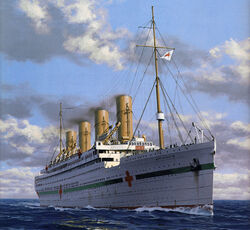
The Britannic.
Britannic, officially known as the HMHS Britannic, was the third Olympic-class vessel and the younger sister ship of the RMS Titanic.
It was originally going to be a trans-Atlantic passenger liner, but World War I broke out, causing the Britannic to be commandeered by the British Navy and turned into a hospital ship. In 1915, Britannic began making routine voyages between Britain and the Mediterranean, aiding wounded soldiers during the war.
Sinking[]
On November 21st, 1916, at roughly 8am, Britannic was traveling through the Kea Channel in Greece when she struck a sub-surface mine on the forward starboard side (in roughly the same spot where Titanic hit the iceberg). All of the watertight doors were ordered closed but the forward bulkheads rapidly filled with water. With the island of Kea nearby, Captain Bartlett restarted the engines. With the steering gear damaged, he ran full speed on the center and port side propellers in order to drive the ship towards Kea. As the deck began to tilt, and the stern began to rise, panic broke out and frightened crew members lowered some boats without permission. Two of those boats drifted into the massive spinning propellers killing all occupants. Upon hearing the carnage, Bartlett stopped the engines to allow all remaining boats to clear the ship. The propellers stopped just seconds before a third boat was going to be chopped to pieces. With the Britannic remaining stagnate, Captain Bartlett restarted the engines again and made one last desperate attempt to reach Kea. When the water spilled over the bow, Bartlett considered the ship a lost cause and ordered the final evacuation. Britannic then listed to starboard and sank in 57 minutes, just half the time it took Titanic to sink. Of the nearly 1,100 people onboard, only 30 perished. 3 killed in the initial explosion and 27 killed by the propellers.
After the sinking of Britannic, the White Star Line never again used the term 'unsinkable' for any of their current or future vessels. Britannic was re-discovered in 1975 by professional oceanographer Jacques Cousteau.

Changes after Titanic disaster[]
- More lifeboats were added to match the capacity of all passengers. Huge lifeboat gantry cranes were added to quickly lower lifeboats in case of an emergency.
- The water-tight bulkheads were raised another five decks. (This should have prevented the Britannic from sinking)
- A second plate of steel was added in the lower mid-section to prevent any type of breach. It was nicknamed the "anti-iceberg hull".
- She was originally intended to be the most luxurious of the trio. A and B decks were re-arranged to accommodate more first class suites and the grand staircase was also going to be different. The grand dining room was also going to have a large organ. Unfortunately due to her acquisition as a hospital ship, very little of the luxury furnishings were installed. After she sank the remaining furnishings were sold at auctions and the organ was put in a museum after it was re-discovered in the 1980's.
- The name of the ship itself. Originally, rumor had it the ship was going to be named Gigantic and was changed to Britannic after the Titanic tragedy. J Bruce Ismay always denied these rumors even though blueprints from December 1911 already show the name Britannic.
Behind the scenes[]
- The wreck of Britannic remains much more well preserved than the wreck of Titanic. It lies in much shallower water and does not require deep-sea robots to access but rather a deep-diving suit. Britannic lies on her starboard side and still remains in one piece apart from a crack in the bow. Britannic herself is currently the world's largest passenger ship on the ocean bottom.
- Britannic was mentioned in James Cameron's Ghost of the Abyss.
- James Cameron dove to the wreck of the Britannic in the Summer of 2006.
- James Cameron looks like Captain Bartlett.